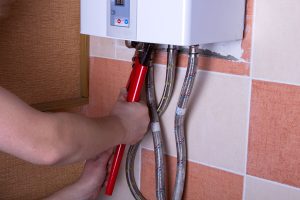Tankless water heaters are a popular choice for many homeowners who want reliable, energy-efficient hot water on demand. Unlike traditional tank-style models, tankless systems heat water only when it’s needed, which means lower utility bills and a longer system lifespan—often as long as 20 years. But that longevity depends on proper care.
While annual professional maintenance is highly recommended, there are several DIY tasks you can do throughout the year to help keep your tankless water heater in peak condition. Here are the top homeowner-friendly tips.
1. Clean the Air Intake Filter
Your tankless unit likely has an air intake filter to keep dust and debris from entering the system. Over time, this filter can get clogged, reducing efficiency and increasing strain on the unit.
How to clean it:
- Turn off the unit’s power.
- Locate the air intake filter (usually behind a panel).
- Carefully remove it and rinse with clean water.
- Let it dry completely before reinstalling.
Check and clean the air filter every 2–3 months—or more often if your home is particularly dusty or you have pets.
2. Flush the System Annually to Remove Mineral Buildup
One of the most important DIY tasks for a tankless water heater is flushing out mineral deposits, especially if you have hard water. Calcium and lime can accumulate inside the heat exchanger, restricting water flow and reducing efficiency.
You’ll need:
- A flushing kit (available at most hardware stores)
- White vinegar or a descaling solution
- A submersible pump
- Hoses
Steps:
- Turn off the power and water supply to the unit.
- Close the hot and cold service valves.
- Connect hoses from your pump and bucket to the service valves.
- Run vinegar or descaler through the unit for 45–60 minutes.
- Flush clean water through the system to rinse it.
- Disconnect the hoses, reopen valves, and restore power and water.
This process helps prevent corrosion, maintain performance, and extend the life of the heat exchanger.
3. Check for Error Codes and Monitor Performance
Most tankless units have a display panel that shows system performance and any error codes. Keep an eye out for:
- Fluctuating water temperatures
- Reduced water pressure
- Frequent shutoffs
- Error codes indicating ignition failure, overheating, or flow issues
If your system is acting up, consult the user manual or contact a professional. Addressing minor issues early can prevent bigger problems down the road.
4. Inspect the Exterior and Venting
Once a month, give your tankless water heater a quick visual inspection:
- Check for leaks around connections or valves.
- Look for rust, corrosion, or water stains.
- Ensure that the venting system (for gas units) is clear of obstructions and securely connected.
Make sure the area around the heater is clean and unobstructed. Don’t store items too close to the unit—especially flammable materials.
5. Clean the Water Filter
In addition to the air filter, most tankless systems have a small screen that traps debris in the incoming water supply.
How to clean it:
- Shut off water to the heater.
- Locate the cold water inlet filter.
- Unscrew the filter and rinse it thoroughly.
- Replace it and turn the water back on.
Cleaning this filter every 6–12 months helps prevent clogs and protects the internal components from damage.
Contact Affinity Gas Services today to schedule an appointment for water softener installation in Gainesville, FL with our professionals. We’re “The Gas Efficiency Experts.”

